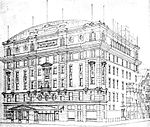Statue of Adam Clayton Powell Jr.
2005 establishments in New York City2005 sculpturesBronze sculptures in ManhattanHarlemMonuments and memorials in Manhattan ... and 6 more
New York (state) sculpture stubsNew York City stubsOutdoor sculptures in ManhattanSculptures of African AmericansSculptures of men in New York CityStatues in New York City

A statue of Adam Clayton Powell Jr., sometimes called the Adam Clayton Powell Jr. Memorial, is installed in Harlem, New York City. The 12-foot (3.7 m) tall bronze sculpture by Branly Cadet was cast in 2005, and inspired by the quote, "Press forward at all times, climbing forward toward that higher ground of the harmonious society that shapes the laws of man to the laws of God."
Excerpt from the Wikipedia article Statue of Adam Clayton Powell Jr. (License: CC BY-SA 3.0, Authors, Images).Statue of Adam Clayton Powell Jr.
Adam Clayton Powell Jr. Boulevard, New York Manhattan
Geographical coordinates (GPS) Address Nearby Places Show on map
Geographical coordinates (GPS)
| Latitude | Longitude |
|---|---|
| N 40.809024 ° | E -73.947933 ° |
Address
USPS
Adam Clayton Powell Jr. Boulevard
10027 New York, Manhattan
New York, United States
Open on Google Maps








